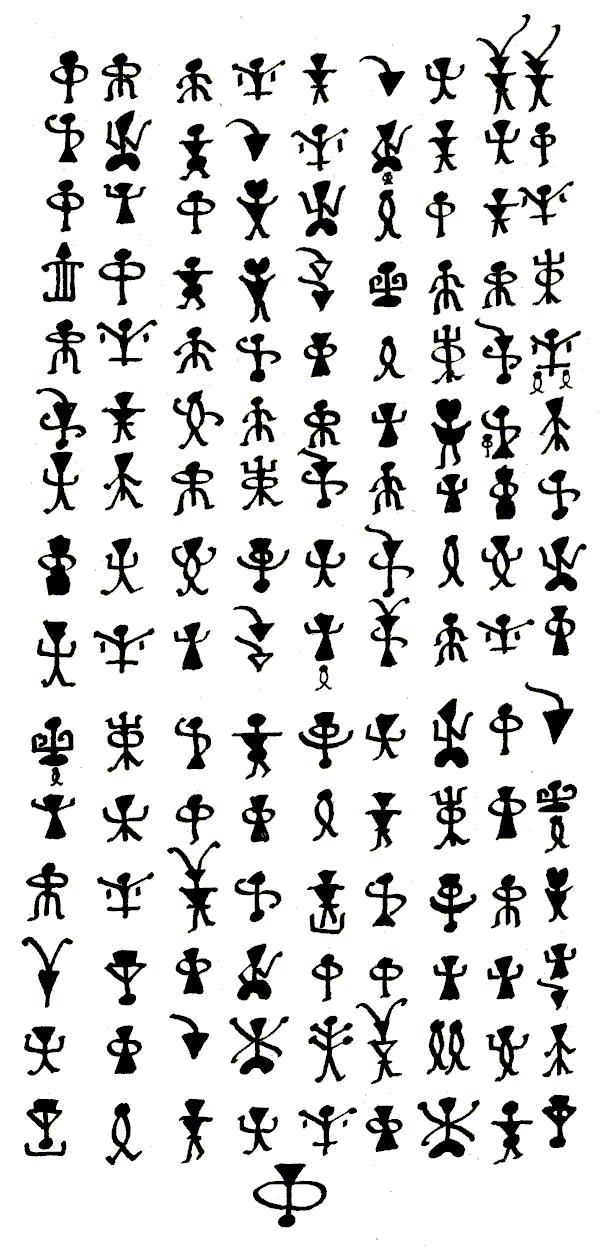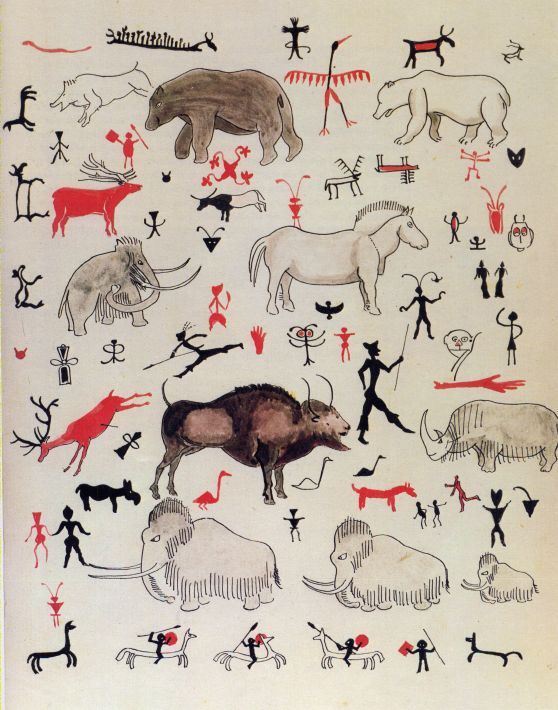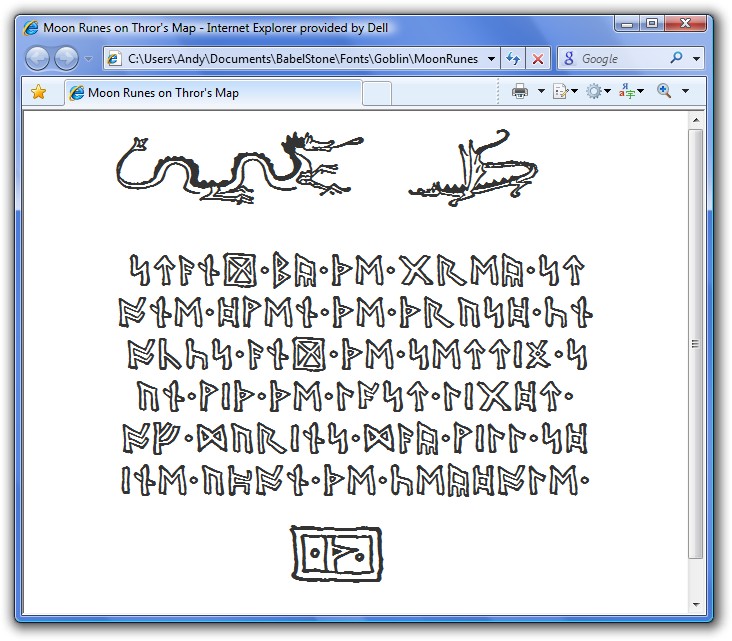BabelStone Blog
Thursday, 1 January 2009
Moon Runes and Goblin Alphabet
It has become a Christmas tradition for me to read to my children Raymond Briggs' Chronicles of Father Christmas and J.R.R. Tolkien's Father Christmas Letters. Taking a Christmas break from Tangut, this year I have finally found time to create a font for the Goblin Alphabet used by the North Polar Bear in the Father Christmas Letters.
Polar Bear's Christmas Letter from J.R.R. Tokien's The Father Christmas Letters (1976)

Like the Mongolian, Manchu and Phags-pa scripts, Goblin is normally written in vertical columns running left-to-right across the page, but it can also be written horizontally left-to-right. As I do not know how to combine vertical and horizontal glyph layout in a single font, I have found it simplest to create two versions of my font, BabelStone Goblin for horizontal layout, and BabelStone Goblin Vertical for vertical layout. The fonts may be downloaded for free from my website.
As discussed previously, Internet Explorer version 8 supports the vertical left-to-right layout that Mongolian, Manchu, Phags-pa and Goblin require, and so I have been able to reproduce quite accurately the layout of the above letter using the vertical version of my font in IE8. The html file that I used is available here, if anyone wants to test it on their system. Note that Polar Bear's letter does not separate words, but I have used ZWNJ as a word separator in the test file in order to inhibit unwanted ligaturing across word boundaries (e.g. the double f of lots of fun); alternatively you could use ZWSP, but although ZWSP works OK in plain text editors such as Notepad and BabelPad, it causes layout problems in more sophisticated applications such as Internet Explorer.
Polar Bear's Christmas Letter as Rendered using the BabelStone Goblin Vertical font in IE8

Unlike most fictional writing systems, Tolkien's Goblin script is not a mere substitution cipher for the English alphabet, but has forty-three individual phonetic letters, an and sign, a letter reduplication mark and a complex system of ligatures. In my font I map the twenty-six Goblin letters corresponding to A-Z to the Basic Latin letters A-Z and a-z (there is no case distinction in Goblin), and contextually generate the glyphs for letters corresponding to digraphs in English (AI, AU/AW, CH, CK, EA, EE, EI, EU/EW, GH, LL, NG, OA, OI, OO, OU/OW, PH, QU, SH, TH, WH) using OpenType technology (i.e. the font automatically transforms the character sequence <A I> to the AI glyph, etc.). Likewise, the font automatically generates special glyph forms for doubled letters. You may use a ZWNJ (ZERO WIDTH NON-JOINER) character to inhibit this behaviour where it is not wanted (e.g. across word boundaries, or in the case of Polar Bear's letter where luck has been written as four letters). In addition to these contextual substitutions which the font applies automatically, there are a number of optional ligatures that the font only applies if explicitly requested by connecting the letters with a ZWJ (ZERO WIDTH JOINER) character. For example, the character sequence <S zwj E zwj E> will be transformed into the special SEE ligature glyph by the font.
Thus any sequence of Goblin text can be represented at the character level by means of the letters A-Z and/or a-z, the ampersand sign (or the plus sign for an alternate form of the and character), and the two format characters ZWNJ & ZWJ. However, as not all systems and/or applications support the advanced OpenType features used in the font, I have also mapped the digraph and ligature glyphs to the PUA at U+E000 to U+E027. On Microsoft Vista correct rendering of all OpenType features in both the BabelStone Goblin and BabelStone Goblin Vertical fonts is seen in basic text editors such as Notepad and BabelPad, and also in Internet Explorer version 8 (when not in compatibility mode, and the HTML document is well-formed and has a valid DOCTYPE declaration). Not unexpectedly, Microsoft Word 2007 does not apply any of the OpenType features in the Goblin fonts (same applies to WordPad), and so if you really must use Word, then you will have to manually enter digraph and ligature glyphs as PUA characters.
A web font version of the BabelStone Goblin font should be automatically downloaded and applied to the table below, but you may also install the font locally on your computer by downloading from here.
| Transliteration | Glyph | Character Sequence (case insensitive) |
PUA Code Point |
|---|---|---|---|
| & | & | & | |
| & | + | + | |
| a | A | A | |
| b | B | B | |
| c | C | C | |
| d | D | D | |
| e | E | E | |
| f | F | F | |
| g | G | G | |
| h | H | H | |
| i | I | I | |
| j | J | J | |
| k | K | K | |
| l | L | L | |
| m | M | M | |
| n | N | N | |
| o | O | O | |
| p | P | P | |
| q | Q | Q | |
| r | R | R | |
| s | S | S | |
| t | T | T | |
| u | U | U | |
| v | V | V | |
| w | W | W | |
| x | X | X | |
| y | Y | Y | |
| z | Z | Z | |
| ai | | A I | E000 |
| au/aw | | A U A W | E001 |
| ch | | C H | E002 |
| ck | | C K | E003 |
| ea | | E A | E004 |
| ei | | E I | E005 |
| eu/ew | | E U E W | E006 |
| gh | | G H | E007 |
| ll | | L L | E008 |
| ng | | N G | E009 |
| oa | | O A | E00A |
| oi | | O I | E00B |
| ou/ow | | O U O W | E00C |
| ph | | P H | E00D |
| sh | | S H | E00E |
| th | | T H | E00F |
| th | | T zwj H | E010 |
| wh | | W H A W | E011 |
| ee | | E zwj E | E012 |
| oo | | O O | E013 |
| oo | | O zwj O | E014 |
| ee | | E E | E015 |
| bb | | B B | E016 |
| dd | | D D | E017 |
| ff | | F F | E018 |
| gg | | G G | E019 |
| mm | | M M | E01A |
| nn | | N N | E01B |
| pp | | P P | E01C |
| rr | | R R | E01D |
| ss | | S S | E01E |
| tt | | T T | E01F |
| zz | | Z Z | E020 |
| cl | | C zwj L | E021 |
| re | | R zwj E | E022 |
| ro | | R zwj O | E023 |
| see | | S zwj E zwj E | E024 |
| ve | | V zwj E | E025 |
| wi | | W zwj I | E026 |
| boo | | B zwj O zwj O | E027 |
For convenience, my Goblin fonts also include specially devised characters for all other characters in the Basic Latin block (digits, punctuation marks, etc.), but these are not canonical, and you need not use them.
Cave Drawings with Goblin Graffiti from the Father Christmas Letter of 1932

Many Goblin letters can be seen in this drawing
Having completed the Goblin font early on New Year's Eve, I have had just enough time to create one more Tolkien-based font, BabelStone Moon Runes, which may also be downloaded for free from my website. This font is based on the moon runes shown on Thror's map in The Hobbit.
I am quite certain that there are already many Hobbit moon rune fonts available, but they are probably all ASCII hack fonts, whereas my font is a Unicode font with the moon runes mapped to the correct characters in the Unicode Runic block. I have extended the character coverage of the font to include all 34 runes of the fully extended Anglo-Saxon futhorc (several of which are only very rarely used), but have not included glyphs for any Runic letters not used in the Anglo-Saxon Runic script. For most people a Unicode Runic font is probably less easy to use than an ASCII hack font, but I do provide several Runic keyboard layouts (this page is temporarily unavailable), including one for the Anglo-Saxon futhorc, which makes it relatively easy to type Unicode Runic text under Windows.
The following is a screenshot of the moon rune text on Thror's map as rendered using the BabelStone Moon Runes font on IE8 under Windows Vista. Note that the glyphs are deliberately rough and uneven, to match the style of writing on the map.

One of the problems with mapping Tolkien's moon runes to Unicode Runic characters is that he uses some runes idiosyncratically to correspond to English letters. In particular, Tolkien seems to use two forms of the same Runic letter, cēn ᚳ (U+16B3 RUNIC LETTER CEN) contrastively, one with a straight stroke for English letter c, and one with a bent stroke for the English letter k (elsewhere Tolkien apparently also uses other idiosyncratic runes, such as a reversed Runic letter sigel ᛋ for English sh, but the c/k runes are the only problematic letters in the Runic inscriptions on Thror's map). I haven't got a satisfactory solution to the c/k issue, but my font uses Tolkien's k-glyph for U+16B3, and contextually substitutes Tolkien's c-glyph for U+16B3 when it occurs before another U+16B3, so that words such as ᚳᚾᚩᚳᚳᛋ (knocks) are rendered with different glyphs for the double Runic letter cēn. Tolkien also uses two quite different forms of the Runic letter dæg ᛞ (U+16DE RUNIC LETTER DAGAZ DAEG D), and the font contextually substitutes the more complex form for the simpler form in certain circumstances. Depending upon your system, these contextual substitutions may or may not work (they work for me in Notepad, BabelPad, Word 2007 and IE8 running under Vista).
For fun, the font also includes three special characters with no Unicode mappings, that can only be accessed indirectly ... and only if your system allows it (should be OK under Windows Vista and 7, although one of the characters is not displayed correctly in Word 2007). One of the secret characters should be easy enough to find if you understand how Unicode works, but the other two can only be invoked by means of the appropriate magic spell (simply type the magic spell and the corresponding character will appear in a puff of smoke).
Update [Christmas Eve 2012]
Michael Everson and myself have submitted a proposal to encode three additional runic letters used by Tolkien ('k', 'sh' and 'oo'), as well as four cryptogrammic Anglo-Saxon runes used on the Franks Casket. These seven runic characters have been accepted for encoding in Unicode, and will appear in Unicode version 7.1 (?) in early 2014 (?). When the version of Unicode containing these characters is finalised, I will update my BabelStone Moon Runes font to include all the seven new characters (I will also update my other Anglo-Saxon runic fonts).
Index of BabelStone Blog Posts
